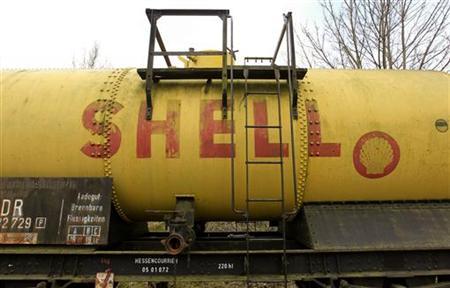Shell Says Gulf Of Mexico Sheen Dissipating
Date: 13-Apr-12
Country: USA
Author: Kristen Hays

An old Shell logo is seen on a vintage fuel wagon at a museum
railway station in the town of Naumburg in northern Hesse March 17,
2012.
Photo: Arnd Wiegmann
Royal Dutch Shell said an oil sheen near two of its offshore Gulf of Mexico oil and natural gas platforms was dissipating Thursday, and it was "very confident" its installations were not to blame.
The Hague-based company said the "orphan spill," estimated to be about six barrels of oil, was breaking up. Shell said it would continue to monitor the sea floor with a pair of underwater robots.
"Shell's subsea surveillance today and tomorrow will continue to determine if there is a connection between natural seeps and this orphan sheen," the company said.
News of the sheen, first reported to U.S. regulators on Wednesday, came nearly two years after BP Plc's deep sea Macondo well blew out on April 20, 2010, killing 11 workers and spewing more than 4 million barrels of oil into the Gulf of Mexico.
The earlier drop in the company's London-listed share price showed that investors remain anxious over potential oil accidents two years after the BP offshore spill, the worst ever in the United States.
Shares of Shell traded on the New York Stock Exchange closed up 11 cents on Thursday at $67.86. The stock closed down less than 1 percent in London after falling as much as 5 percent earlier in the day, temporarily erasing roughly $12 billion in value from Europe's largest oil company by market capitalization.
The sheen, spotted about 50 miles away from the Macondo well, was estimated to be six barrels of oil stretched one mile by 10 miles before it began dissipating.
"The sheen appears to be dissipating," the Bureau of Safety and Environmental Enforcement (BSEE) said in a statement, after inspecting the area with helicopter overflights. "It does not appear to be expanding."
Shell's robot surveillance, in addition to overflights at the scene by the U.S. Coast Guard, showed no signs of wellhead leaks, the company said.
A source familiar with the incident told Reuters that Shell was nearly 100 percent sure that the sheen stemmed from a natural seep rather than an oil well.
The BSEE, which regulates offshore oil and gas activity, said on Thursday that its personnel spotted the sheen on Wednesday near Shell's Mars and Ursa platforms and notified the company.
The BSEE said the ROVs were assessing permanently plugged wells in the surrounding area "and a known natural sea floor seep located in proximity of the sheen."
BSEE said it also directed pipeline companies with operations in the area to survey their lines.
Shell said a Marine Spill Response Corp vessel with skimming and boom capability was deployed to the site, but was released by the Coast Guard Thursday afternoon to return to shore, a source familiar with the incident told Reuters.
Shell spokeswoman Kelly Op de Weegh also told Reuters that the company took samples of the sheen to undergo testing at a laboratory to ascertain whether it came from a natural seep.
The Mars platform can produce up to 160,000 barrels of oil and 121 million cubic feet of natural gas per day. Ursa can produce up to 150,000 barrels of oil and 400 million cubic feet of gas per day.
Both are about 130 miles southeast of New Orleans, and are about seven miles apart.
The Marine Spill Response Corp is a nonprofit organization created in 1990 by the oil and shipping industries to enable members to fulfill requirements of the U.S. Oil Pollution Act of 1990.
(Additional reporting by Matt Daily in New York, Anna Driver in Houston and Adveith Nair in London; Editing by Helen Massy-Beresford, Sofina Mirza-Reid, Jim Marshall, Chris Baltimore, Gary Hill)
![]()
© Thomson Reuters 2012 All rights reserved